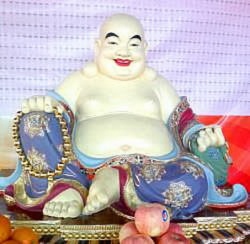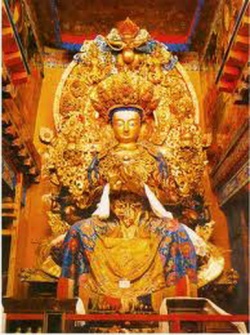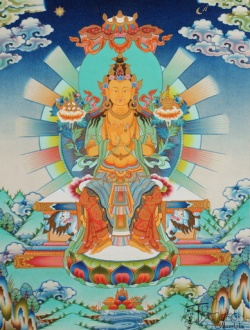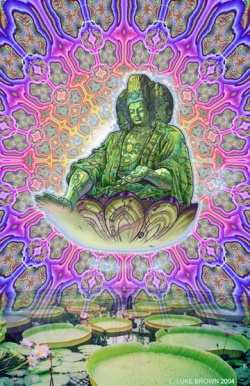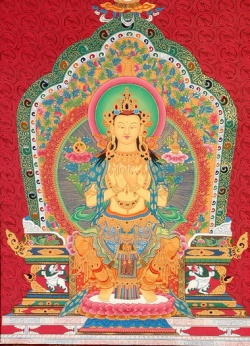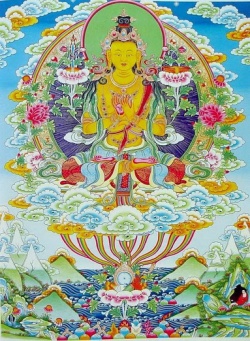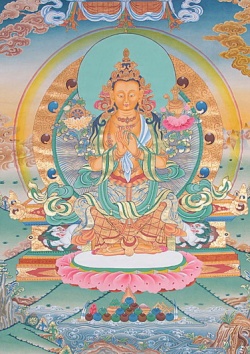Maitreya Bodhisattva
Maitreya (Mi Le in Chinese; Jampa in Tibetan; Miroku in Japanese) Bodhisattva is a future buddha. His name, Maitreya, means the "loving one". He resides in the Tushita heaven currently. He is to join this world after the end of the third period of time after the passing of the Sakyamuni Buddha. The first period is known as the first turning of the dharma (buddhist law/doctrine) wheel which is to last 500 years. The second period is known as the deteroriation of the dharma which is to last about one thousand years. The third period called the "turning of the wheel of the second law" is believe to last three thousand years.
Maitreya (Jampa or "Friend") is the future Buddha, often depicted seated on a chair (bhadrasana, seat of rank) holding a lotus with a stupa emerging from it. Sometimes he holds a dharmachakra or a vase containing nectar which, here, symbolizes the Buddhadharma purely preserved.
In the China of the 1350's, still under the administration of descendants of Kublai Khan, Maitreya the Buddha of the Future, was the focus of the revolutionary sect referred to as Red Hats/Turbans. Han Lin-erh, leader of the northern band, declared himself Emperor.
Perhaps because of the familiar pose of this bodhisattva, every now and then someone in the West claims to be Maitreya, a figure that is a parallel of a Messiah or a Mahdi, but other traditional indicators have not as yet coincided.
Maitreya is a bodhisattva revered by Buddhists of most schools. His name derives from the Sanskrit word maitri meaning caring or "loving-kindness" (in Pali, metta.) He is one of the few deities depicted in paryanka asana -- seated with legs hanging, like a Westerner. He is currently believed to be functioning in the Tushita heaven, and will be born on earth for the benefit of beings 4, 000 years [or 5, 000, according to another source] after the passing of Shakyamuni Buddha.
A scriptural source for this date is Shakyamuni's response to Shariputra's questions (The Surangama Sutra.) He responded that Maitreya would appear before the last of The Five Disappearances:
The disappearance of Attainments, the disappearance of Method, the disappearance of Learning, the disappearance
of the Symbols [the outward forms) and the disappearance of the Relics ... .
And, regarding that last disappearance:
Then when the Dharma of the Perfect Buddha is 5,000 years old, the relics, not receiving reverence and honor, will go to places where they can be received ... .
Various groups, including authorities of belief systems other than Buddhism, calculate the date according to their own agendas.
Asanga's devotion to Maitreya, Two Views and a Dog.
The Maitreya Project initiated by the FPMT under Ven. Zopa Rinpoche (d. 1984) in honour of the 1,000th anniversary of Buddha Shakyamuni.
On 16 hectares of land near the Bodhgaya temple in the Indian state of Bihar state, the new statue of the seated figure of Maitreya will be three times as tall as the Statue of Liberty, and is intended to last for 1,000 years. The 500-foot (152.4 m.) bronze-clad statue designed and constructed by an international group of architects and engineers will have an inner steel framework.
The five-year project will cost around $200 million to be raised through donations. Bihar is one of the poorest regions in India, and the project which includes a village complex will create over 1,000 jobs for local people. The Indian Government plans to build an airport nearby.
Laughing Buddha or Fat Buddha
Bodhisattva Maitreya (Chin: Mileh-fo, Jap: Miroku Butsu or Bosatsu) is often depicted as a fat, laughing monk whose belly some considered auspicious to rub.
He is also referred to as The Monk with the Cloth Bag. However, that image is based upon Chang Dingzi (907-1060) a Buddhist monk who was a native of Chekiang Province. He was an itinerant who wandered about at the end of the Tang and beginning of the Wu-Tai Dynasties propagating the Dharma. Though dressed only in thin monk's robes, he could lie on the snow without getting cold and wet, and he also had the ability of foreseeing the future. One story says that he had an eye on his back; perhaps he saw the past, too.
Besides being a yogi, he was also a learned man, but everyone addressed him as Pu Tai -- 'calico bag' or 'cloth bag' after the large bundle that he carried wherever he went. He soon became worshipped as the incarnation of Maitreya.
It is possible that the fat belly is symbolic shorthand for the Chinese idiom that is used to express someone who is exceedingly tolerant -- has a "big stomach." The monk may really have been fat, or since Maitreya is a bodhisattva with limitless compassion, the quality of character that is shown by an actual "big stomach" is further emphasized by the laughing expression and a version that has numerous, little children (noisy, too, no doubt) swarming over him. As Laughing Buddha, he is called in one Chinese transliteration, "Ta-pao Mi-Lei-Fwo."
The fat belly and the children later led women to rub the belly of images of Mileh Fo a.k.a. Pu Tai, in hopes of conceiving children through his influence.
Maitreya Bodhisattva ~ Loving-One
Maitreya Bodhisattva is the future buddha of this world who currently resides in the Tushita Heaven. A Dictionary of Buddhist Terms and Concepts relates the following information about him:
"A bodhisattva predicted to succeed Shakyamuni as a future Buddha. Also called Ajita, meaning 'invincible.' Some accounts view him as a historical personage who preceded the Buddha in death. He is said to have been reborn in the Tushita Heaven where he is now expounding the Law to the heavenly beings there. It is said that he will reappear in this world 5.670 million years after Shakyamuni's death, attain Buddhahood, and save the people in Shakyamuni's stead. For this reason he is also sometimes called Miroku Buddha. Belief in Miroku prevailed in India around the beginning of the first century A.D., and spread to China and Japan. In the fourth century, a monk named Maitreya (c. 270-350) became famous as a scholar of the Consciousness-Only school, and was later identified with this bodhisattva." (pp. 266-7)
Maitreya Bodhisattva is the only bodhisattva who is revered by both Theravadin and Mahayana Buddhists (aside from Siddhartha Gautama and his past lives as a bodhisattva). His coming is predicted in the Pali Canon as well as in the Mahayana Sutras.
In addition to the legendary fourth century teacher of the same name, Maitreya Bodhisattva has had many other appearances in history. The most famous is of the jovial monk whose statue is often mistaken as that of the Buddha. Taigen Daniel Leighton relates the following about this well-known but misunderstood figure:
"In China Maitreya is nearly synonymous with his supposed incarnation as the historical tenth-century Chinese Zen monk Budai, whose Japanese name, Hotei, may be more familiar in the West. Chinese images of Budai, or Hotei, are frequently labeled simply 'Maitreya' (Milo in Chinese) such that in popular Chinese awareness they are virtually identical. Hotei is legendary as a wandering sage with supernatural powers who spent his time in village streets rather than in the security of temples. His image is recognizable as the disheveled, fat, jolly 'laughing buddha' whose statue is seen in many Chinese restaurants and in all Chinese Buddhist temples.
"Hotei's name means 'cloth bag,' as he carried a sack full of candies and toys to give to children, with whom he is often depicted in play. This scruffy Buddhist Santa Claus expands our view of Maitreya's warmth and loving-kindness. Hotei's fat belly and affinity with children reflects yet another aspect of Maitreya in popular folk religion, that of a fertility deity. Maitreya was sometimes prayed to by those who wanted children, especially in Korea."(Bodhisattva Archetypes, p. 260-1)
Bodhisattva Maitreya plays a large role in the Lotus Sutra. In the first chapter, it is he who inquires of Manjushri Bodhisattva the reason for the miraculous signs displayed by the Buddha. Taigen Daniel Leighton summarizes and comments on this chapter as follows:
"Maitreya appears in a highly ambivalent light in some of the early Mahayana sutras. In the very first chapter of the Lotus Sutra, Shakyamuni Buddha emits a light from between his eyebrows that puzzles Maitreya, who questions Manjushri. Manjushri reminds Maitreya that in a remotely past buddha land they had witnessed a similar light emitting from a previous buddha, a light which had heralded the teaching of the Lotus Sutra on behalf of that buddha by a bodhisattva named Fine Luster, none other than Manjushri himself.
"Among Fine Luster's eight hundred disciples, one named Fame Seeker Bodhisattva was actually Maitreya in a former life. This Bodhisattva Seeker of Fame was named thus because he craved personal profit and advantage; although he read and memorized numerous sutras, he derived no benefit and quickly forgot most of them. Although Maitreya, or at least his past life, is thus dishonored by his former teacher Manjushri, the bodhisattva of wisdom goes on to say that the slothful Fame Seeker also did many kind deeds. These allowed him to train with numerous buddhas over many lifetimes, until now he was finally the Bodhisattva Maitreya, destined to be the next buddha." (Ibid, p.246-7)
Maitreya Bodhisattva has a large role in the Ceremony of the Air as well. It is he who inquires after the origin of the Bodhisattvas of the Earth in chapter 15. He is also the one who asks how Shakyamuni Buddha could have taught them when he had only attained enlightenment 40 years before their appearance. It is this second question which prompts the revelation of the Buddha's enlightenment in the uncountably distant past in chapter 16. In chapter 16, it is Maitreya Bodhisattva who heads the assembly in declaring that they will faithfully receive the Buddha's answer. In chapters 17 and 18 it is Maitreya Bodhisattva whom the Buddha addresses when explaining the boundless merits of those who accept the teaching of the Buddha's unborn and undying nature with faith.
The closing chapter of the Lotus Sutra makes reference to Maitreya Bodhisattva in a more favorable light than in the first chapter. Taigen Daniel Leighton explains:
"Although the Lotus Sutra opens with Manjushri's rather dim view of Maitreya's distant past, the final chapter of the Lotus Sutra, delineating Samantabhadra's protection of students of the sutra, offers a more positive view of Maitreya and his future. Samantabhadra certifies that those who read the Lotus Sutra and understand its import will be reborn in Maitreya's Tushita Heaven. Samantabhadra describes this realm as highly meritorious and beneficial, as Maitreya abides there already possessing the marks of a buddha, accompanied by a retinue of bodhisattvas and goddesses." (Ibid, p.247)
Praise of Maitreya Bodhisattva:
In the past he was the immortal Wisdom Light,
His samadhi of great kindness is wonderful beyond expression.
Born in the south, in a country of adornment called sea shore,
He ascends to the Tushita heaven, and Buddha in his next life he'll be.
With perfected mind and consciousness whose brightness spans the realms of the ten directions,
The merit and virtue cultivated in his nature he simultaneously fulfilled.
Many are those who obtain rebirth in the inner courtyard,
As they assemble at the dragon-flower assembly and first receive a prediction.
Homage to Maitreya Honored Buddha who dwells in the inner courtyard of the Tushita heaven, who with ten thousand virtues replete, waits to become Buddha in his next life.
"Maitreya" means "compassionate clan." He is also known as "Ajita" which means "invincible." He regards all living beings with compassion and is foremost in the perfection of patience. He will be the next Buddha in the future. He is the founder of the Consciousness-Only School in Mahayana Buddhism.
His images are placed in the dining halls in Buddhist temples.
The Venerable Master Hsuan Hua explains:
If someone strikes him, he lies down and goes to sleep, letting them beat him as they please. He doesn’t lose his temper. If someone spits on his face, he simply lets it dry by itself, without bothering to wipe off. Since he doesn’t fight back, the other person cools off too. This kind of paramita/method for reaching the other shore is a treasure among wonders. Once you know this news, how can you fail to attain the Way?
A verse in praise:
The mind gives rise to all things;
All things are created from mind alone.
With no afflictions or worries,
He is perpetually laughing.
In the samadhi of happiness,
He brings forth people’s good roots.
Since he never forgets to have fun,
Spring returns to the Dharma Realm.
…With the “happy samadhi,” he causes people to plant good roots. Probably he made a vow that anyone who set eyes on him would be inspired to bring forth the Bodhi Resolve.
Another verse says:
If you ask me what I’m laughing about,
First let me ask you what you are crying for.
Neither crying nor laughing is the Middle Way.
Why get attached to either side?
In a single gulp, swallow your worries & grief.
With two eyes, see through those who pursue fame and profit.
No one recognizes the Bodhisattva;
Everyone misses him at close range.
…If you know why you are crying, you’ll understand why I’m laughing…Crying is not the Middle Way, nor is laughing. However, the Bodhisattva uses laughter as a means to save those who are sad or afflicted. Why get attached to either side? Crying and laughing are extremes; they are not the ultimate principle of the Middle Way. They fall to one side or the other, and are not the path of cultivation that we should take…
